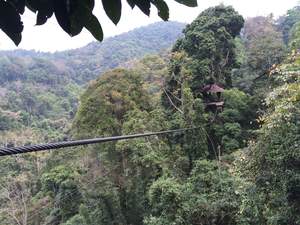
Ziplining in Thailand: My Face Hurts from Smiling
This morning I went ziplining through the rainforest. I haven't stopped smiling since. It's not even for the reasons you might think. Why does my face hurt, then?
It was calm

No, really. I can't tell you if it was the months of jumping off of scary things in parkour, the just trust I gained driving a motor scooter in Phuket, or just Thailand itself, but nothing, all day, was genuinely scary.
Most of the other folks in my group had their share of screams and eeks and I can't do that's, but for me, mostly it was just engaging, amazing, and a ton of fun.
At a few points, I watched the stories I tell about myself come out of my mouth as we queued to clip in: I'm afraid of heights, or on the "superman" jump, where you're clipped in from behind and there's slack in the line - so there is only air to catch you when you jump, I could never skydive because of the jump.
 The cable for the 800-meter span, disappearing into the rainforest.
The cable for the 800-meter span, disappearing into the rainforest.
But when I got to that edge, it was easy. I just jumped. No heart racing, no real risk or fear. Just the wind whipping, canopy flying by.

It was with the most reputable company
If you spend more than 8 hours in Chiang Mai, you'll start to feel overwhelmed by the advertisements for Flight of the Gibbon. They are everywhere - on the backs of tuk-tuks, on local businesses, on stands by the roadside.
Gibbon seems, at first glance, to be a hideous tourist trap. It's certainly expensive - 3,000 Thai Baht (~100USD). There are dozens of knock-offs, all of them cheaper, and I was seriously considering one - until I talked to a friend who had taken a cheaper option on one of her visits. The safety gear wasn't done right, and she said she spent the whole time worrying about not dying, instead of enjoying it.
Flight of the Gibbon is the opposite. It was super professionally done, the guides really knew their stuff and the equipment, and you were clipped in at every moment.

They were also hilarious, and did a great job of keeping it fun, educational, and light-hearted. Our lead guide had been doing it six years, and though he said as we talked afterwards that it was probably time for him to start looking for another job (catching overweight tourists is really, really hard on your back), his experience showed. He knew when to add some scary, and he knew when to dial it back.
Most importantly though, the company, through and through, pulsed safety. That is a rare thing, here in Thailand, and when you're 60 meters off the forest floor, and about to jump off onto an 800 meter span, you're very, very grateful.
It was sustainable*
This is a loaded statement, and I have so many conflicting thoughts about travel and sustainability that they might just end up becoming a book of their own. However, in the relative world that is actual reality, here's a few points in Gibbon's favor.
They actively work on education and conservation projects.
When I started looking into doing this, I dug through the company's website, reviews, and external reports. It turns out, they're genuinely doing good things. The company is engaging with deforestation and habitat loss with a combination of education (of both locals and tourists) and action (reforesting with native plants, reintroducing species that were hunted to extinction.)
These days, I don't really believe in perfect. But I do think that's a pretty darn good place to start.
 There are four gibbons in this picture. I promise.
There are four gibbons in this picture. I promise.
They charge more money.
3,000 Baht is a lot of money. In fact, that's just about what I spend on food here in an entire month. But, in this case, it's money well spent.
 Good money means good awkward safety gear.
Good money means good awkward safety gear.
It means better wages for the workers, from the guides to the bus drivers to the cooks. It means better equipment and more safety. And it means more impact - or environmentally, less.
20% of their profits go to the local villages for conservation efforts. 10% go to Gibbon conservation and reintroduction programs. Paying more means there's spare money to go around and put towards sustainability programs. I can't tell you how happy I am to contribute.
They work conservation education into the experience.
This wasn't expected, and was really lovely. There was a discussion of native and non-native plants, habitat loss, hunting, and the changing relationship between people and forest.
We were introduced to the fauna and flora, told the names of species, and the interactions at different times of the years.
I learned about the strangler tree, a tree that germinates in the treetop crevices of other tall trees, then grows down, eventually planting multiple roots, and strangling off the original tree. On the final abseil down, I stood on a platform 50 meters off the ground, surrounded by two 500 year-old trees: an Oak, and the Strangler Fig that would eventually kill it.
 Oak underneath, strangler crawling down from above
Oak underneath, strangler crawling down from above
 The platform where the above picture was taken. Full-grown man on the ground, for scale.
The platform where the above picture was taken. Full-grown man on the ground, for scale.
And yes, it was gorgeous
It was exactly as awesome as what you're imagining. There were platforms nestled in the top of five-hundred year old trees. You clip onto cables and zoom between them, the jungle flying beside and below you, all your senses soaking it in.
The landing platforms ranged from simple to elaborate. One even had a spiral staircase, circling the tree ala Lord of the Rings.
 You get to cross these sorts of bridges.
You get to cross these sorts of bridges.
 And walk down staircases like this.
And walk down staircases like this.
 And abseil down beneath this canopy.
And abseil down beneath this canopy.
As a kid, I spent almost all of my free time up in trees.
Today, I got to play in the treehouses I'd always dreamed of.

